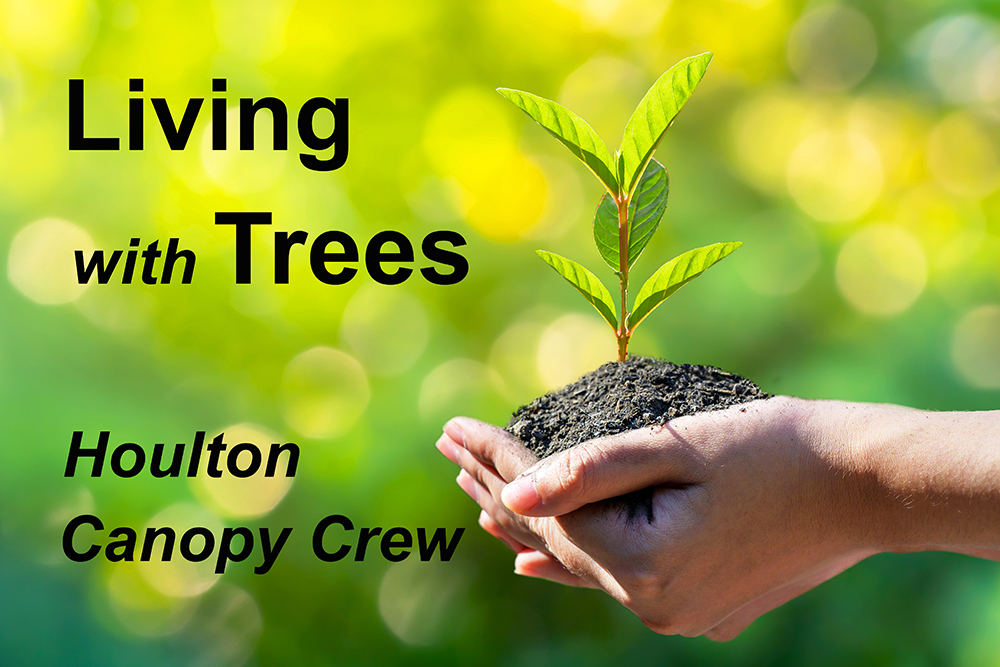Surely one of Houlton’s treasures in the Riverfront Trail. Every time I walk it, I am grateful for its beauty and peace, and I say a word of thanks to those whose efforts, money and skill created and help to maintain this gem.
The trail is marvelous any time of year, decked with snow, greening in spring, lush in summer. On Dec. 19 (right after the big rain and wind storm), I walked it with two dear and observant friends. We took the almost three mile main trail, discovering many generous offerings.
The air was warmer and the water a few feet higher than usual — signs to me of climate change and the need to both mitigate against it and prepare for it. The river was running gloriously fast (the Meduxnekeag never fails to captivate), with larger volumes of water. And we saw much foam, likely caused by decaying plant material enriching the river with nutrients, gathered along the banks.
Not far from the trail entrance, mallard ducks swam in a sheltered spot, created by the high water among trees normally landlocked. Three green-headed males and two brown females seemed to be enjoying small red fruits — crabapples? — that had dropped from a tree. It was a joy to watch them, to spot a robin flying low across the path and to hear squirrels chattering. A bird’s nest or three nestled in the leafless branches above us. It’s always good to take a glance up.
A few of the bare trees wore black knots, round black fungi that affect cherry and other trees, killing that section but providing insect habitat. Other trees, particularly snags (dead or dying trees), sported woodpecker holes. We found large rectangular openings, probably from pileated woodpeckers excavating colonies of ants or beetles, as well as small holes just started. My research bids me watch also for bark sloughed off, and rows or scatterings of tiny cavities, made in the woodpeckers’ search for tasty sap and insects.
Along the woods edge of the field hung the shells of wild cucumbers, non-edible, green in the summer but now tan puff balls covered with soft spines. They grow amidst the burdocks, whose not-so-soft spines hook into anything. And in the wider fields, brown seed clusters of late summer goldenrod feed many birds, while a few milkweed seeds, toxic to most species, still cling to their pods.
Down on the ground in the woods, many plants have lost their greenery. But not the Christmas fern, its glossy dark green fronds lovely all year. The Eastern wood ferns remain a lighter green — and what’s this? Fiddleheads, it seems, poking up through small mounds at the end of the river path, perhaps another sign of global warming.
We found, along with the tall spruce, fir and cedar trees, several patches of Canadian yew, evergreens a foot or so high. It seems there is always something new to discover. I use a free app called Seek to identify natural life. It also connects to i-Naturalist, allowing us to engage in citizen science.
Most of the trail’s deciduous trees have lost their leaves, but brown leaves still cling to a few beech trees. One large “winter beech” stands at the edge of the power line clearing. Some of the maples along the river are still holding clumps of “helicopter” seeds, awaiting, as I understand it, a big spring release. Other trees simply delight with the shapes of their trunks — like the yellow birch that took a graceful side turn, perhaps due to damage years ago, before continuing its reach to the sky.
Meanwhile, a downed limb by the river offered bi-colored bracket, a new (for me) mushroom. It was just one species of numerous mushrooms, spore-producing fruiting bodies of hidden fungal networks, enjoying the nutrients of dead trees, stumps, bits of wood or popping up in the ground.
There was common lichen clinging to many trees, and along the path windblown clumps of usnea, or Methusalah’s beard, a lacy lichen whose inner thread will, if pulled very carefully, stretch a bit. And there were mosses everywhere, feather mosses and pixie cups and others. One stump next to a tree could have been a softly covered emerald throne.
As my friends and I walked, we cleared branches blown into the path, and we clambered over a couple of downed trees. We also stopped at the “Christmas tree” in one of the fields to hang a few ornaments, as others have before, a bit of community whimsy.
It was a space of well-being. As we emerged from the trail, a half moon was riding high in a clear sky, a golden sunset just beginning. I was reminded of two words my grandnieces often use, “notice” and “wonder.” And two other words ever in my spirit, “gratitude” and “joy,” as we walk and love the trail.
From the Houlton Canopy Crew, committed to caring for Houlton’s trees and gardens. For more information, call Angela Wotton at 254-4126.








